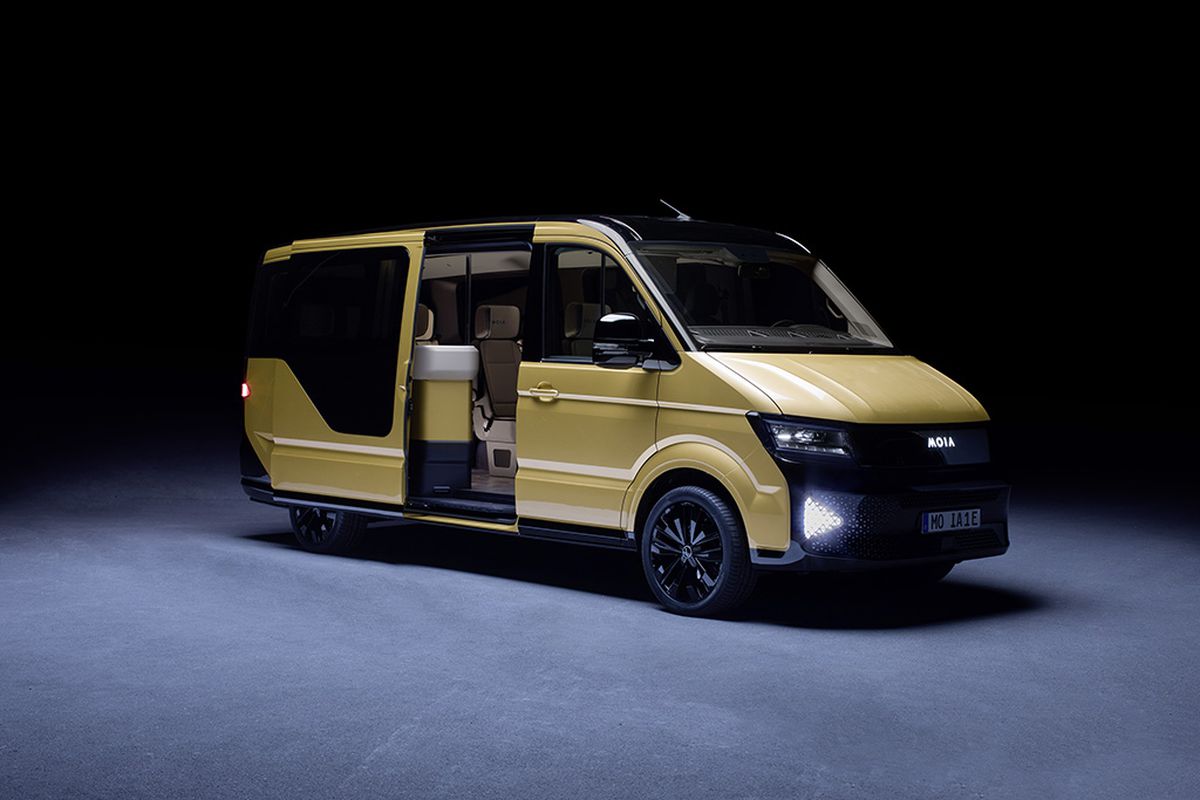/cdn.vox-cdn.com/uploads/chorus_image/image/57876019/2_MOIA_Car_TechCrunch_2017.0.jpg)
This week, a subsidiary of Volkswagen called Moia unveiled a new concept vehicle in Berlin: a six-seater all-electric van. Blandly brown in color and retaining none of the flash typical of other concept vehicles, the Moia EV probably flew under the radar for most people. But what’s interesting about it is that the vehicle is designed for ride-hailing services like Uber and Lyft, and more specially for carpooling. And Moia isn’t the only company that sees the advantage of a large wheelbase vehicle as the perfect hedge against an uncertain future.
Over the last year, the auto industry has been leaning into minivans, vans, and shuttles as the types of vehicles best suited for these shared, pooled rides, either with a human driver or an autonomous one. Thanks to a convergence of self-driving technology, ride-sharing and car-sharing apps, and battery-electric vehicles, OEMs (original equipment manufacturers) are rushing to respond to shifting consumer habits. And the fact remains, the classic four-door passenger sedan just doesn’t cut it anymore.
“Well, if you’re a believer in the autonomous vehicle future, then the MOIA EV has to be the kind of people-moving super cab that VW and others have to develop,” said Michael Ramsay, an analyst at Gartner. “When we get down to it, these vehicles are small buses, operating, one would hope, in a more efficient way than current bus and paratransit systems.”
VW plans to go into production on the Moia EV starting next year, which is truly remarkable for a concept just unveiled this week. The company plans to launch a “ride-pooling concept” in Hamburg next year with a fleet of 200 of the electric vans. The goal, according to Moia CEO Ole Harms, is to reduce “the number of cars in major cities by one million in Europe and the USA by 2025.”
Other car companies have their own shuttle buses and minivans in operation. Ford acquired the San Francisco-based micro-transit service Chariot last year and has been steadily expanding its presence in cities across the US. General Motors and its subsidiary Cruise Automation have been piloting an autonomous taxi service in San Francisco using a fleet of electric Chevy Bolts. (The Bolt isn’t a van, of course, but GM has said it will release 20 new all-electric vehicles by 2023.) And Waymo, the self-driving division of Alphabet, has deployed fully driverless Chrysler Pacifica minivans in a suburb of Phoenix for its own ride-hailing pilot.
/cdn.vox-cdn.com/uploads/chorus_asset/file/9630431/waymoCastle_26__1_.jpg)
/cdn.vox-cdn.com/uploads/chorus_asset/file/7793821/navya_autonomous_shuttles_las_vegas_1.jpg)
Speaking of Waymo, it seems increasingly apparent that many people will first experience autonomous driving technology not through vehicles owned by giant companies like Google or Uber, but as passengers in tiny, autonomously driven shuttle buses that are popping up in cities across the country. These self-driving shuttle services are quickly becoming the must-have tourist attraction for many municipalities. These vehicles, which are built by startups like Local Motors, May Mobility, and Navya, have appeared in places like Las Vegas, Denver, and Washington, DC. Their routes are simple, and seating is limited, but many see these tiny vehicles as a gateway to introducing automated driving to a broader swath of the population. (That is, when they’re not crashing.)
And when you look at some of the flashier concept vehicles unveiled recently, you find even more examples of how the industry is trending toward larger, multi-passenger vehicles. In Geneva earlier this year, VW showed off a quirky autonomous minivan called Sedric with no steering wheel or pedals, that can be summoned at the push of a button for ride-hailing trips. It looked like a grumpy toaster, but its interior was designed to look more like a lounge than a six-seater airport shuttle.
“I don’t consider this a gimmick, but rather a crucial part of the mobility ecosystem,” said Sam Abuelsamid, an analyst at Navigant. “Mobility services will need to operate with a variety of different vehicle types that can support different uses and price points.”
Minivans and shuttles have other advantages beyond additional legroom. There is flexibility to switch back and forth between carrying cargo and people based on demand, Abuelsamid said. And with the addition of automation, these vehicles could be manufactured to have swappable interior modules, with seats or package racks or even drone charging and deployment for package deliveries. Heavy GPUs to power self-driving software can fit snugly in a more spacious trunk.
To be clear, ride-hailing still accounts for less than 1 percent of all vehicle miles traveled in the US. But services like Uber and Lyft are increasing their foothold in major metropolitan areas. A recent study of big cities found that 21 percent of adults have personally used ride-hailing service. Meanwhile, additional research seems to suggest that the rise in Uber and Lyft may lead to a complementary drop in personal vehicle ownership.
And while they haven’t quite hit their sweet spot yet, it’s clear that both Uber and Lyft view carpooling as vital to their respective missions of dominating cities and growing their share of the market. Riders love the cheap, subsidized fares, drivers are warming up to it as the technology improves, and cities love the idea of utilizing every seat in the vehicle to maximize the value of the trip. So naturally, with all the trends swirling through the air, automakers are increasingly turning toward the multi-passenger vehicle as the ultimate representation of their commitment to the future.
What will become of the lonely sedan? Extinction seems a likely course. According to a recent study, the rise of shared mobility services could slash demand by more than half for driver-owned sedans by 2025. KPMG projects that sales of personally owned sedans in the US will drop precipitously — from 5.4 million units sold today to just 2.1 million units by 2030. This could spur a faster shift by automakers toward the production of SUVs and pickup trucks, which already outsell sedans by large margins.
But if you’re talking about utilization, nothing approaches the efficiency of public transportation. Tech companies may see minivans and shuttles as the ideal mode of transportation, but city buses and subways are still the most efficient way to move large groups of people across (or underneath) dense urban environments. Lyft caught some flack earlier this year when it unveiled something called “Lyft Shuttle,” the description of which sounded pretty much identical to a city bus. But the message was clear: private companies were encroaching on the turf of public transit agencies, with uncertain consequences.
It raises an important question about fairness and equity. As public transportation in many major US cities degrades, frustrated commuters are turning to ride-hailing and ride-sharing services. This can supplement and bolster these floundering transit services (as some transportation experts predict), or it can undermine them. Smelling profit, auto companies make bold claims about rolling out new vehicle types and launching their own mobility services. Technology is transforming transportation, and the hope is that we’ll get as much out of this transformation as we can. It will take more than a few flashy minivans before we get there.





